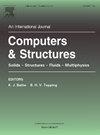Modular-topology optimization for additive manufacturing of reusable mechanisms
IF 4.4
2区 工程技术
Q1 COMPUTER SCIENCE, INTERDISCIPLINARY APPLICATIONS
引用次数: 0
Abstract
Modular designs have gained popularity because they can generally address manufacturing efficiency, reusability, and sustainability concerns. Here, we contribute to the growing field by proposing a fully automatic design method for modules utilized in several products. Our manufacturing-aware procedure is composed of three consecutive steps: (i) free-material optimization for obtaining the optimal spatially distributed elasticity tensors, (ii) hierarchical clustering of the stiffness tensors directly into a given number of modules while allowing for their flipping, and (iii) single-scale topology optimization with manufacturing aspects to design the final topology of mechanically compatible modules. These aspects include connectivity constraints to ensure the integrity of all modules and the three-field projection to account for manufacturing inaccuracies. We illustrate the entire procedure with the design and fabrication of eight different reusable modules assembled into well-functioning modular inverter and gripper mechanisms. These mechanisms were 3D printed and subjected to mechanical testing using an in-house testing machine and digital image correlation. The experimental results show excellent agreement between the predicted and observed behavior and highlight the potential of the method for scalable additive manufacturing.
可复用机构增材制造的模块化拓扑优化
模块化设计越来越受欢迎,因为它们通常可以解决制造效率、可重用性和可持续性问题。在这里,我们通过提出一种用于多种产品的模块的全自动设计方法,为不断发展的领域做出贡献。我们的制造感知过程由三个连续的步骤组成:(i)获得最佳空间分布弹性张量的自由材料优化,(ii)将刚度张量直接分层聚类到给定数量的模块中,同时允许它们翻转,以及(iii)制造方面的单尺度拓扑优化,以设计机械兼容模块的最终拓扑。这些方面包括连接性约束,以确保所有模块的完整性,以及考虑制造不准确性的三场投影。我们通过设计和制造八个不同的可重复使用模块来说明整个过程,这些模块组装成功能良好的模块化逆变器和夹持器机构。这些机构是3D打印的,并使用内部测试机器和数字图像相关进行机械测试。实验结果显示了预测和观察行为之间的良好一致性,并突出了该方法在可扩展增材制造方面的潜力。
本文章由计算机程序翻译,如有差异,请以英文原文为准。
求助全文
约1分钟内获得全文
求助全文
来源期刊

Computers & Structures
工程技术-工程:土木
CiteScore
8.80
自引率
6.40%
发文量
122
审稿时长
33 days
期刊介绍:
Computers & Structures publishes advances in the development and use of computational methods for the solution of problems in engineering and the sciences. The range of appropriate contributions is wide, and includes papers on establishing appropriate mathematical models and their numerical solution in all areas of mechanics. The journal also includes articles that present a substantial review of a field in the topics of the journal.
 求助内容:
求助内容: 应助结果提醒方式:
应助结果提醒方式:


